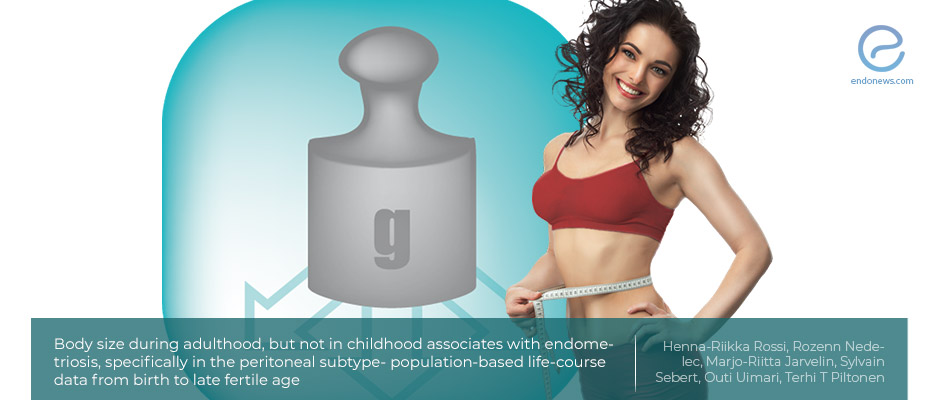The association between body size and endometriosis
Feb 10, 2021
Endometriosis is generally associated with a leaner body type in adults, but not in adolescence.
Key Points
Highlights:
- No associations between endometriosis and birth weight or adiposity were observed in childhood or adolescence.
What’s done here?
- The association between endometriosis and its subtypes and body size development is investigated in 348 women with endometriosis and 3487 women without endometriosis from birth to age 46 years from the Northern Finland Birth Cohort.
- At ages 14, 31, and 46, follow-up data were collected through postal questionnaires and clinical examinations.
- The data included height, weight, and waist and hip circumference measurements.
Key results:
- The association between endometriosis, specifically of the peritoneal subtype; and low body mass index, waist circumference, and waist-hip ratio was inverse.
- In birth, childhood and adolescence the body size in terms of weight, height, and BMI were comparable between the population who later developed endometriosis or not.
- Women with lower weight and BMI at age 31 seem to have a higher risk of endometriosis. For each kilogram of weight and for each BMI the risk was 2% and 6% lower, respectively.
- Women who had developed endometriosis had a lower mean weight than women without endometriosis at age 46, especially for peritoneal endometriosis.
- When endometriosis subtypes analyzed, there was an inverse association between peritoneal endometriosis and weight, weight gain from age 14 to 46, waist circumference, and waist-hip ratio .
- However, contrasting peritoneal endometriosis, for ovarian and deep infiltrating endometriosis there was a tendency for positive associations between all body size measures.
Limitations:
- The body size data at age 14 may not be as accurate, since they were based on parents’ reports.
- There may be some degree of selection bias for the study groups.
Lay Summary
Until today there have been few studies investigating body size in childhood and adolescence in women with endometriosis.
A new study published recently in the journal Acta Obstetricia et Gynecologica Scandinavica provides further evidence of the associations between endometriosis, body size and adiposity. Researchers found an inverse association between endometriosis, specifically of the peritoneal subtype, and a smaller body size in terms of body mass index, waist circumference, and waist-hip ratio.
The team led by Uimari and Piltonen investigated a large population with a homogeneous female population in terms of age, ethnicity, and access to health care. Based on the Northern Finland Birth Cohort 1966, the study analyzed the data of a total of 348 women with and 3487 women without endometriosis.
Follow-up data of the cohort were collected at birth and ages 14, 31, and 46 through postal questionnaires and clinical examinations and included height, weight, and waist and hip circumference measurements. The researchers assessed the associations between endometriosis and body size.
The analysis revealed that there are no associations between endometriosis and birth weight or adiposity from childhood to age 20. No associations were seen between endometriosis and weight, height, and BMI at age 14. Since age 14, those with endometrioisis had gained less weight since age 14, and women with endometriosis showed lower mean weight than women without endometriosis at age 31. Up to age 31 women with endometriosis were found to have a smaller WC and a lower WHR at reproductive age. Women who had developed endometriosis, especially peritoneal endometriosis had a lower mean weight than women without endometriosis at age 46. However, contrasting peritoneal endometriosis, for ovarian and deep infiltrating endometriosis there was a tendency for positive associations between all body size measures when subtype analysis was performed.
According to the authors, more studies evaluating the role of factors affecting body size development are needed to explain the mechanism underlying the association between peritoneal endometriosis and a lean body shape.
Research Source: https://pubmed.ncbi.nlm.nih.gov/33550615/
endometriosis body weight body mass index waist waist-hip ratio body size adiposity subtype

